Care
Like the rest of its congeners, caustic sedum survives well in almost any conditions.
The only thing he really needs is sunlight.
Therefore, even a child can take care of this plant.
Planting and transplanting
Planting and caring for caustic sedum is quite simple.
He has few roots, the more they are thick and strong - therefore, they can be damaged only with a strong desire.
Only leaves and flowers can suffer during transplantation. But, fortunately, this will not turn out to be anything terrible - the decorativeness of the plant can be easily restored.
When transplanting, it is advisable to keep an earthen lump. Most likely the plant will take root in any case, but why risk it in vain. Moreover, it is much easier to keep an earthen ball than to remove it.
A favorable time for planting (transplanting) is a period of active growth, that is, spring, summer, early autumn.
Sedum does not like transplants. Therefore, it needs to be transplanted infrequently - about once every 5 years.
Soil and fertilizers
With regard to soil requirements, all types of sedum can be divided into two groups.
The former prefers nutritious loamy soils.
The second, to which the caustic sedum belongs, is not demanding on the soil and even feels better in poor conditions. Many gardeners confirm that sedum is more likely to bloom in poor and sandy soil.
When drawing up a mixture for sedum, it is recommended to limit yourself to sand, ash, a small amount of compost soil or humus. Mineral fertilizers are not needed to improve growth and are even undesirable.
Nitrogen fertilization can accelerate plant growth, but at the same time weaken it and make it vulnerable to disease. To take risks or not is up to the gardener.
When growing sedum both in a pot and in the open field, there must be good drainage. In its absence, there is a high probability of a bay, which is very dangerous for this plant.
For indoor sedums, a layer of expanded clay is added to the pot, and for plants growing in open ground, the top layer of soil is loosened and sand is added.
Many stonecrops need regular weeding, as they cannot withstand competition at all. Caustic sedum is an exception.
He secretes a poisonous juice that solves all land conflicts. For this reason, you should not plant any other type of plants next to the caustic sedum.
Watering and humidity
Sedum growing outdoors practically does not need watering.
Only a very young plant can be watered during a particularly dry period of summer. Excess moisture is harmful to the plant - the soil must dry out before each watering.
Humidity does not play a big role in sedum, as it naturally grows in arid areas. Therefore, the plant does not need spraying.
Lighting
The only thing that caustic sedum is demanding is sunlight. The plant should be placed in a well-lit area throughout the year. Only in such conditions the leaves have a bright color, and flowering is possible.
Insufficient lighting forces the plant to stretch. The decorative effect is lost, the leaves turn pale, and flowering is unlikely.
It is well known that dust is capable of trapping a significant amount of light. In order for the plant to receive maximum illumination, it is recommended to wipe the leaves from dust from time to time.
If the plant is kept in the house, windows should be washed regularly. In autumn, during the fall of leaves, you need to ensure that dry leaves from the trees do not remain on the stonecrop foliage.
Flowering and pruning
The sedum caustic begins to bloom around May, and can finish both in June and July.After the end of flowering, you need to cut the peduncles so as not to deplete the plant.
The plant does not like frequent transplants, but if it grows in one place for too long, it begins to lose its decorative qualities. Leaves fall off, shoots elongate, and flowers become small and pale.
Therefore, during each transplant (every 4-5 years), the plant needs to be rejuvenated - divided or redrawn.
Temperature regime
The caustic sedum belongs to the most hardy and unpretentious representatives of the genus. Even in snowless and frosty winters, they do not need an artificial shelter, in the spring they always acquire a "presentation".
In summer, sedum feels great in any heat and drought.
Caring for stonecrop in the garden
When growing sedum, weeding should be done regularly.
But there is such a species called caustic soda. Its peculiarity lies in the fact that it independently frees itself from unnecessary grass. Due to this ability, it is often used in alpine slides and flower beds. But other varieties suffer from weeds. So they must be removed regularly. Water the plant only at a time when there is no natural rainfall for a long time and the land suffers from drought. The stems grow well. Therefore, from time to time they need to be trimmed to avoid awkward dimensions. In order for the plant to decorate the garden for a long time, leaves and flowers that begin to wither should be cut off. There are varieties that have shrubs of different colors. Therefore, they also need to remove all green leaves. After winter and summer, you need to feed the greens. For this purpose, apply:
- Complex mineral dressing
- Organic dressing
- Bird droppings 1 part to 20
- Infusion of mullein 1 part to 10
It is not allowed to use fresh manure for such purposes.
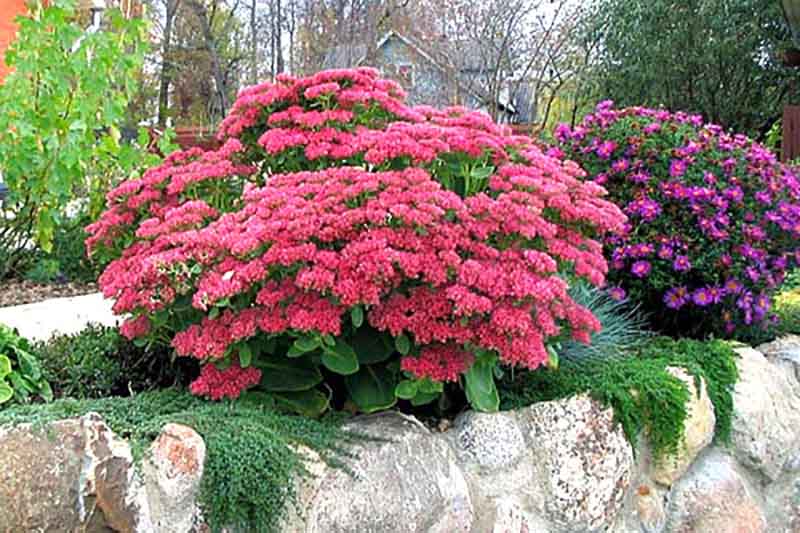
Sedum in the garden
Stonecrop propagation
Those plants that belong to the ground cover species are allowed to be cuttings before or after flowering. This is done in the following stages:
- A stalk about 8 cm long is taken from the stem.
- Leaves that are located below are removed.
- Deepen into the mixture of loose soils so that there is at least one node in the soil.
- When the stalk is rooted, it can be moved to a new place in which it will already grow all the time.
In spring, cuttings, when they were cut off, should be immediately planted in open ground.
In the fall - differently. Several cuttings are taken and placed in a vase. From time to time, the water inside needs to be changed. When spring comes, such sprouts will already have roots. So by this time they can already be placed in open ground. It happens that even before the onset of spring, the cuttings take root. In this case, they should be planted in different pots. Then in the spring they are moved to a new place already for a permanent time.
It is important not to forget that in this plant it is permissible to immediately root the stems in any part, completely. If everything is done correctly, then out of 10 seedlings 7-10 will grow
For this you need:
- The soil under the shoots is cleared of weeds, fertilized, leveled and compacted.
- The stems are pressed close to the ground.
- The soil mixture is laid on top. It includes sand and garden soil.
- This layer is also compacted.
Bushes of large sizes and adults, which have already reached 4-5 years of age, can be propagated by division. Sedum propagates as follows:
- In the spring, it is removed from the soil.
- All soil residues are removed from the root system.
- The shrub is divided into several separate bushes so that each one has buds and roots.
- Sections are treated with a preparation containing a fungicide.
- The resulting plants are taken to a place where it is cool and a lot of shade until excess moisture evaporates from them. This usually takes several hours.
- Then they are moved to new territory.
Transfer
The plant can not be transplanted for 5 years and this will not affect its condition. After which it should be rejuvenated.This includes removing old shoots, filling with new soil, fertilizers to the level of the roots. Whenever possible, sedum will be best transplanted. This is done using the methods described earlier.
Reproduction methods
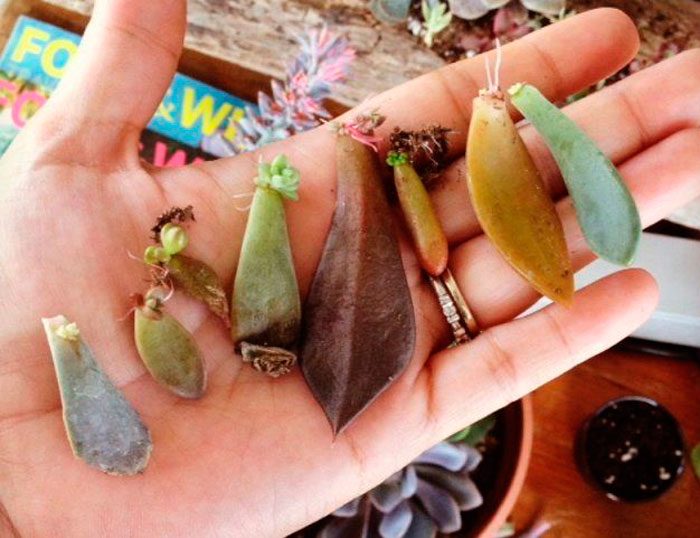
Propagation of sedum by cuttings
For propagation of domestic sedum, the method of cuttings is used, while cuttings can be taken from leaf and stem. Planting cuttings for rooting is recommended immediately after cutting. Stem cuttings are planted in a loose and moderately light soil mixture, for example, you can combine sod and leafy soil with sand (4: 2: 1). For planting, use a low and wide bowl, while covering the cuttings from above is not necessary. They should give roots in about 2-3 weeks, and when another 15-20 days have passed, the plant can be planted in separate containers that need to be filled with sand, turf and leafy soil (1: 1: 1). For rooting of leaf cuttings, sand is used, and then they are planted in the same soil mixture as the stem cuttings. The room where the cuttings are located must be regularly ventilated.
Seed reproduction
Such a flower can be grown from seeds in spring or autumn. For sowing seeds, use bowls or low boxes. In order for the seedlings to appear much faster, the crops are recommended to be removed to the greenhouse. After the plants have a second or third true leaf plate, they must be cut into low pots, which are filled with a substrate for seedlings (the composition is described above). The bush can bloom after 3 years or later, but only if it is properly looked after and provided with optimal conditions for growth.
Description of the plant
The sedum is also called Sedum. Among them there are ground cover, low-creeping species, the height of which is from 3 to 20 cm. There are also tall varieties - up to 80 cm. They are not so tenacious, do not like drought, and need watering.
Distinguish between seducers:
by the shape of the peduncle;
leaf color;
leaf shape.
The advantage of sedums in rapid reproduction, if it is necessary to urgently close any part of the garden bed, flower bed. They bloom brightly and for a long time. In winter, it does not fade - it remains green. Resumes vital activity in the spring. Survives in winter in the middle lane.

There are also negative aspects: a ground cover sedum planted on an area where there is a vegetable garden nearby can become a real disaster. It reproduces by seeds that are smaller than poppy seeds, so it is almost impossible to track everything. Once in the ground, the seeds germinate immediately and populate the entire territory in a short time.

Roots underground form impassable thickets for other ornamental, berry and vegetable crops. As a result, all other plants experience nutritional difficulties and cannot fully develop.
If you cut off the layer of earth where sedum grows, the soil will not fall apart, but will keep in one piece, since the roots branch strongly and hold the soil around them. It is very difficult for other plants to germinate through such a layer.
Important! When planting a sedum flower in a flower bed, steps must be taken to control the reproduction of this species, otherwise it will turn into a persistent weed. Sedum planting and care should be monitored annually
Varieties
Botanists count about 500 types of stonecrops. Some specimens are considered domesticated. It is them that are grown in garden plots as ornamental plants. They are distinguished by their colorful appearance and unpretentiousness.

Let's consider in more detail several of the most popular types of stonecrop:
- Common: It is a tall perennial plant with an erect, thick stem. In height, it can reach 25 cm. The leaf plates of the plant are quite dense and flat. Small denticles can be seen along the edges of the oval-shaped leaves. This species blooms in July. A shield brush appears at the very top.It contains many star flowers with beautiful stamens.
- Prominent. This type of sedum grows naturally in Asian countries. The plant is considered to be of medium height. The stems reach a height of 50 cm. The rhizome looks more like a tuber. The stems grow straight up, the leaves of a bluish-green color densely extend from them. Above the jagged wavy foliage, there is a whole cap of umbellate inflorescences. The diameter of the flower is approximately 15 cm.
- Purple. This variety is a perennial plant. Height can reach 65 cm. Dense leaves spread on erect stems. They are quite fleshy and alternate. The leaf plate can reach 9 cm in length.From June to September, umbrella inflorescences of a rich or delicate pink appear. The degree of coloration depends on the growing conditions as well as on the composition of the soil.
- Caustic. The stems of a plant of this variety are highly branched. They can reach a height of 10 cm. The oval-shaped leaves fit tightly to the stems. Small teeth are visible along the edges. By themselves, the leaf plates are quite small. Their length can reach 6 mm. Peduncles of this variety are shortened. Loose inflorescences with golden yellow buds are formed on them.
Each gardener chooses varieties based on their preferences. Plants can be purchased for indoor and outdoor planting.
1. Seven Secrets of Success:
| 1. Growing temperature: during the growth period they are kept at a temperature of 18 to 26 ° C, in winter - some species need a cool dormant period at a temperature of about 10 - 12 ° C. Many sedum plants are grown at room temperature throughout the year. |
| 2. Lighting: light shade from the direct rays of the sun on hot summer days, in spring and summer the flower can take sun baths in the morning and evening. |
| 3. Watering and Humidity: Water abundantly in spring and summer, but allow the top third or even half of the soil to dry out between waterings. In winter, watering is reduced in accordance with the temperature of the content - often they simply protect the substrate from completely drying out. There is no need to increase the air humidity. |
| 4. Features: stonecrops are extremely attractive and at the same time extremely undemanding plants - they are easily grown by novice growers. |
| 5. Soil: loose, may be poor in nutrients, but well-drained soil with a high content of river sand. |
| 6. Top dressing: mineral fertilizers for succulent plants once a month from spring to autumn. In winter, the plant is not fed. |
| 7. Reproduction: stem cuttings, dividing during spring transplantation or seeds. |
Botanical name: Sedum.
Stonecrop flower - family
Where it grows, homeland. The plant originates from Asia.
Description. What is sedum? Sedum is a large genus that includes about 600 species of very diverse in appearance plants, which are evergreen or deciduous, annual, biennial or perennial shrubs and shrubs.
Other names are sedum or rejuvenated.
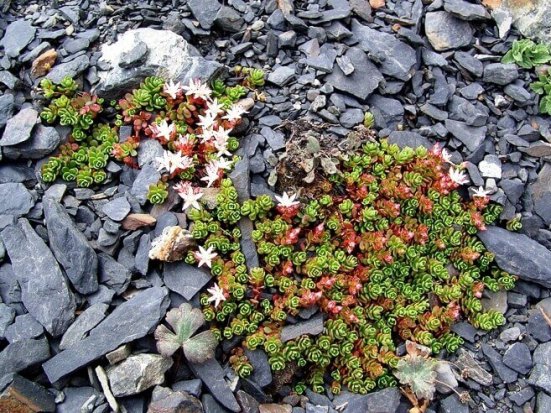
Height. Sedum indoor reaches a height of 10 cm to 60 cm, it depends on the species. The growth rate of different plants is also different.
The final sizes of the plants will vary depending on the conditions in which they are kept.
Stonecrop propagation
Sedum can be planted in any of three ways of reproduction: by seeds, cuttings or dividing the bush.
Seed propagation
The seed method can be used in two ways. Just sow the seeds into the soil at the place of "permanent residence", in the previously prepared soil. The best time for sowing seeds: late April - early May.
Advice! The seeds do not need to be planted very deeply in the ground, as the seedlings are very delicate and will not be able to break through the thick ball of earth.It is better to sow them on top of the soil and cover them with a thin layer of sand.
The second method is to plant seedlings in a flower garden. To do this, fill the flower box with a mixture of earth, sand and humus (1: 1: 2), water lightly, sow seeds (as mentioned above) and cover with glass or foil. When the emerging seedlings have already grown up, they can be transplanted into open ground.
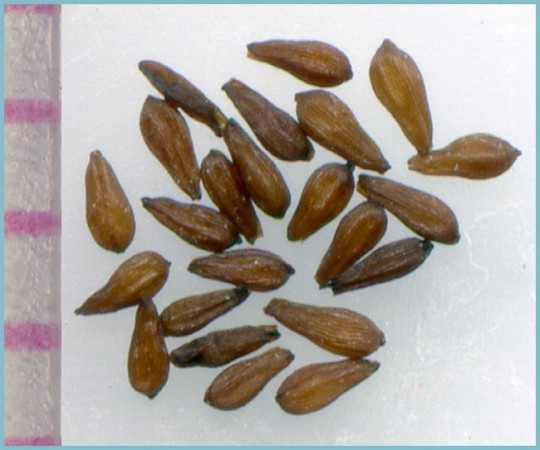 Sedum seeds
Sedum seeds
Propagation by cuttings
Any adult stonecrop stalk will do to get a planting stalk. It is necessary to cut off a part of the stem and plant it in a previously prepared place, deepening it into the ground by 3 cm.
Reproduction by dividing the bush
Every 5 years, sedum must be transplanted to a new place. Better to do this in the spring. The plant should be dug up, and the overgrown bush should be divided into 3-4 bushes. Fracture points must be treated with powdered activated carbon. Dry the bushes for a couple of hours in a dark place and can be planted.
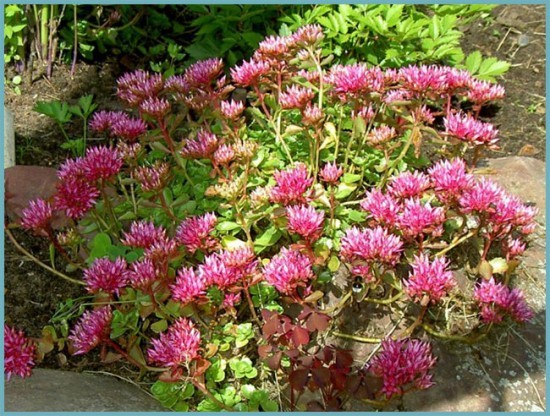 The culture reproduces painlessly by dividing the bush
The culture reproduces painlessly by dividing the bush
Planting and care at home
In general, stonecrops are picky about the conditions and undemanding in caring for them, they love heat, but plants are resistant to frost. Following the minimum rules will ensure your garden is always blooming and beautiful.
Landing
These perennials can be planted in the ground from early spring until the first frost. Planting should take place in a closed root system (with soil from the nursery in which the plant was located).
When planting, it is important to choose the right location: sedum should not grow in a place where many leaves will fall from above in the fall, they will drown it out.
Lighting
They love a sunny location, they can also grow painlessly in partial shade. The higher the intensity of the sun, the higher the plant will stretch upward, with lower illumination, the further it grows along the ground.
Also, with more intense light, the color of the leaves becomes brighter, juicier.
In insufficient light, they may stop blooming.
Temperature
The sedum easily copes with a prolonged drought and can easily endure the winter.
The optimum air temperature for the highest flowering intensity is 20-25o C.
Watering
When planting or replanting, it is very important to ensure good frequent watering in order for the plant to take root better and faster. You can also increase the amount of moisture during the flowering period.
During the dormant period, the plant has no special requirements for the watering regime.
Photo of sedum of Kamchatka variegata (sedum variegated).
Air humidity
With increased air humidity, the plant changes in appearance - the color of the leaves becomes richer, the leaves themselves are solid in structure.
Top dressing
Sedum Kamchatka is a self-sufficient type of plant; it does not require additional feeding in the form of mineral fertilizers. However, the use of nitrogen fertilizers and compost is well perceived, as a result of which the abundance of flowering significantly increases, up to the unrecognizability of the species.
You can sprinkle some humus on top of the plants in preparation for winter.
The soil
Almost indifferent to the choice of soil. In wildlife, it grows on rocky slopes and rocky crevices. When planting in the garden, it is enough to do with sand, with the addition of a small amount of ash and compost.
Dormant period
During the dormant period, the plant is still beautiful, in the decor it performs the function of sheltering the soil, looks aesthetically pleasing and attractive, and requires very little care.
Pruning
Plant care is minimal, all that is required is to cut off dried inflorescences. There is no need to cut it off from a decorative point of view, since Sedum Kamchatsky grows very neatly and aesthetically.
It is also recommended to cut off the longest shoots of plants immediately after the first frost.
Transfer
When transplanting a plant, a prerequisite is to ensure that the root system is closed and thoroughly watered. Shading will also be an advantage.
Reproduction
It is very easy to breed Sedum Kamchatka, there are several options: seeds, cuttings, dividing the rhizome.
Seeds need to be sown either in spring or autumn, in boxes in a garden bed or greenhouse.
When propagating by division or cuttings, it is necessary to dig out the plants or cut the stalk in early spring, then carefully cut it so that the root and buds are preserved on each part, dry it for several hours in the shade, and you can plant it.
In order to root a twig or stalk, just good regular watering is enough, it will take root in any light. Will feel best in variable shade.
Pests and diseases
The species is very resistant to pests, easily fights against them on its own. Caterpillars may appear during the height of summer. In this case, you can treat the plants with a special agent, or there is still another effective way: lure them with lettuce leaves.
It is very rare, but aphids can also be found, even less often - weevil, thrips. In this case, you still need to treat the leaves with special means, those intended for processing black currants are recommended, since they are the least harmful.
Summing up, we can conclude that Sedum Kamchatsky is a unique and practically unpretentious plant that does not require much effort in caring for it, but thanks to its properties and beauty, it brings a little exoticism and sophistication to the landscape.
Pruning
Stonecrop flower grows very quickly. As a result, the stems can become bare, which makes the plant look unkempt. Timely pruning will help to avoid this. Distinguish between rejuvenating, sanitary and regulating pruning. The haircut must be done regularly. All weakened and damaged stems must be removed without fail.
Pruning of perennial varieties is recommended in the fall. It is best to do this after a severe cold snap. At this time, it is recommended to cut all the stems to the same level with the soil. The resulting hemp is covered, and the soil near the plant is mulched. With the onset of spring, young stems will appear on the bushes again.
The purpose of such pruning is to rejuvenate the bush and give it a decorative shape.
All manipulations should be carried out with extreme caution. Tools used for trimming must first be decontaminated.
Sedum after flowering
Seed collection
Before picking, it is important to remember that the variety obtained from these seeds will not resemble its native one. It blooms until severe frosts and preserves the green color of the leaves until winter
This in turn makes it more difficult to collect the seeds.
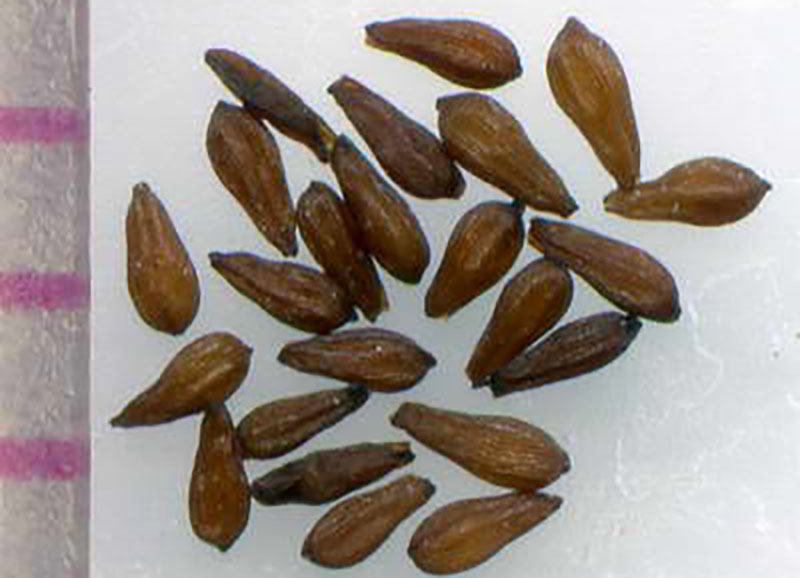
Stonecrop seeds
How to prepare for wintering
When the first severe frosts have passed, the shrub should be pruned. The remaining trimmed branches above the ground should be no more than 3-4 centimeters in length, after which they are covered with a layer of soil. If in winter a stonecrop bush, covered with snow, does not bother you, you can not cut it
But when spring comes, it will be extremely important to produce, for the reason that it will lose its attractiveness


